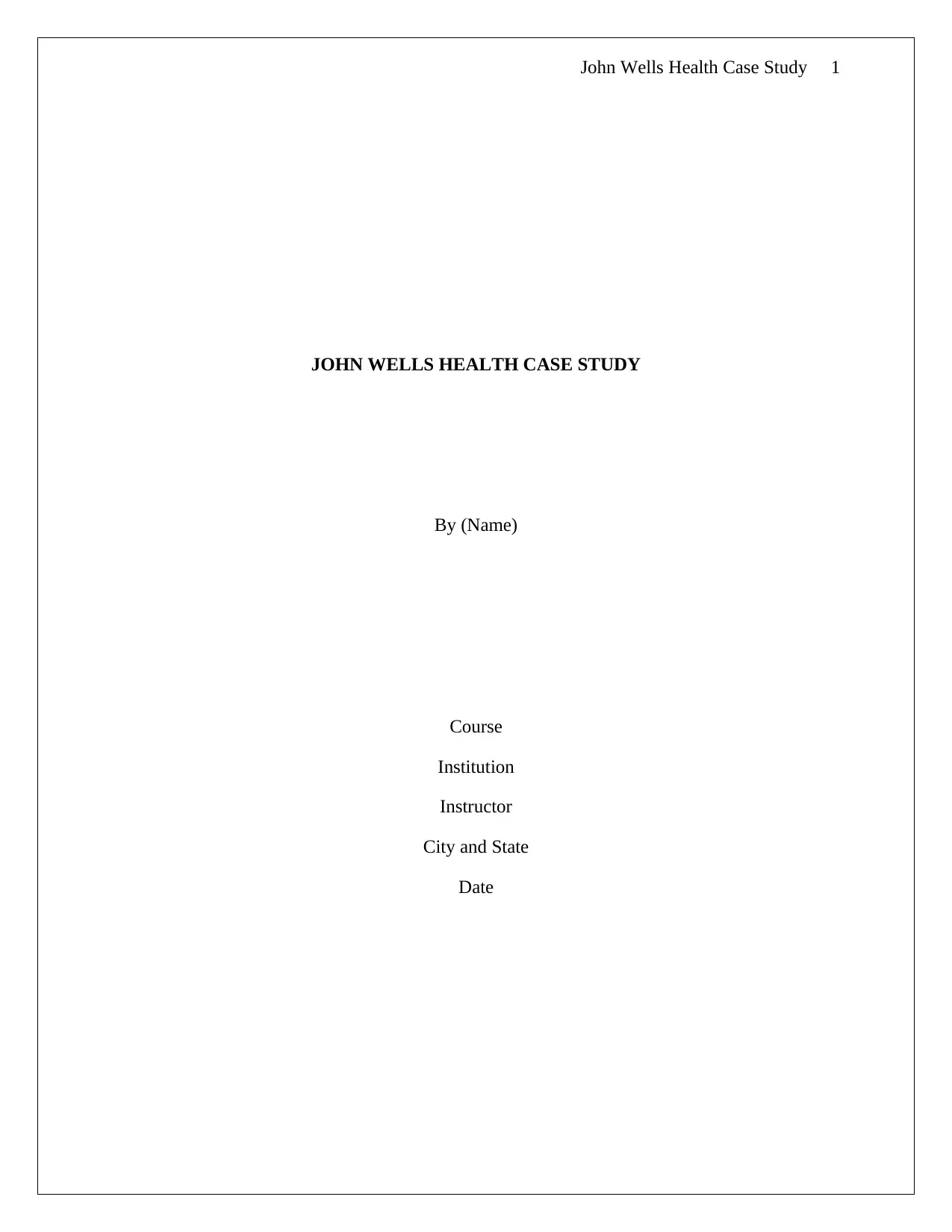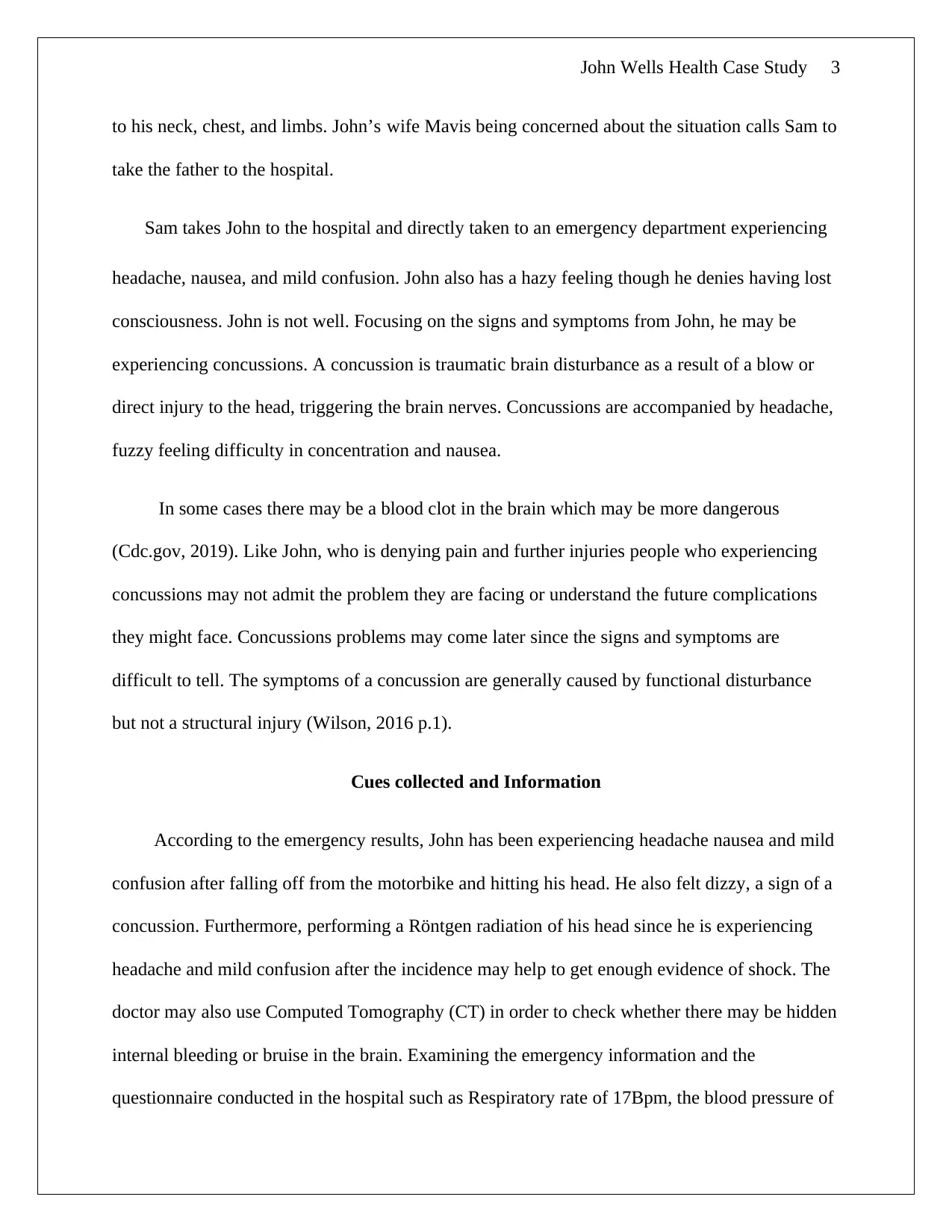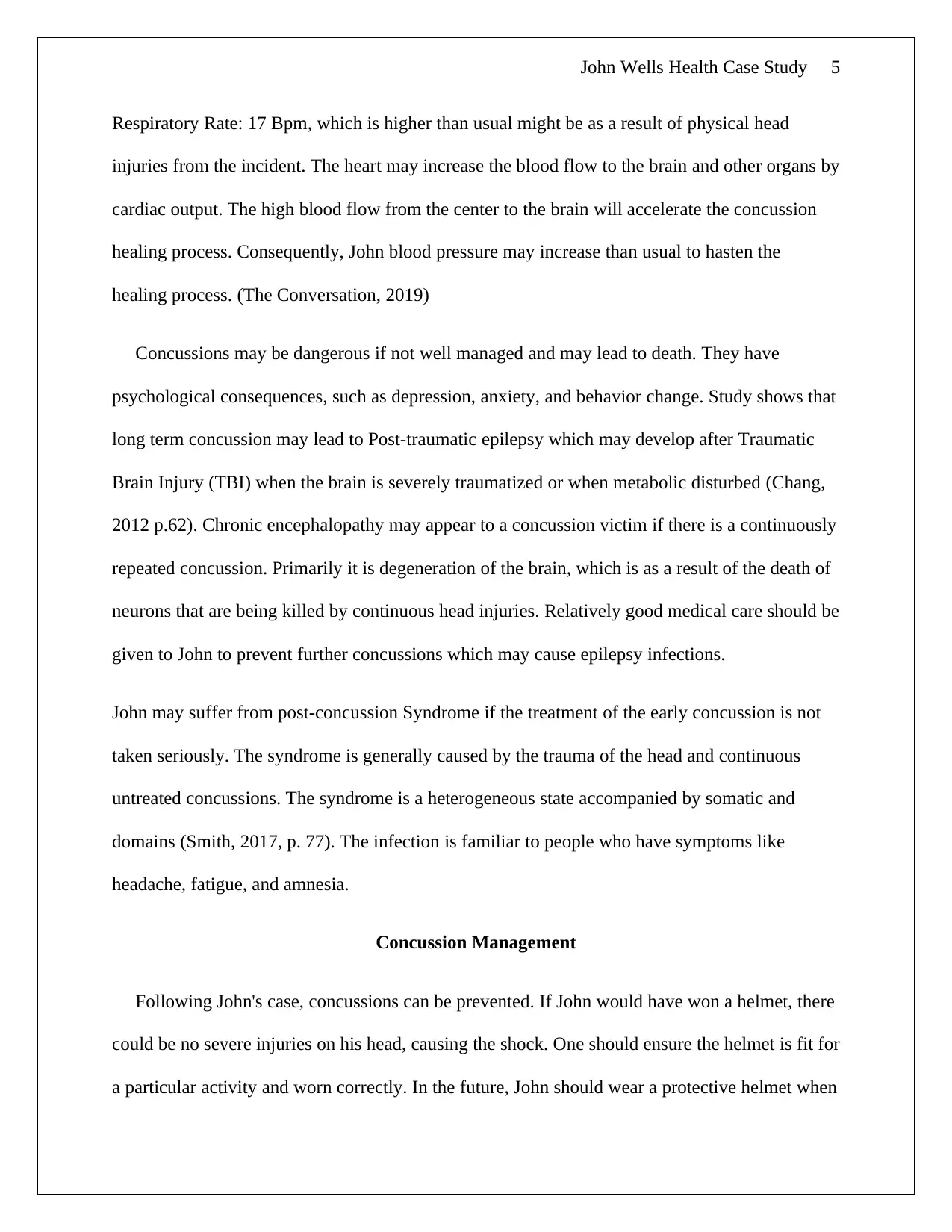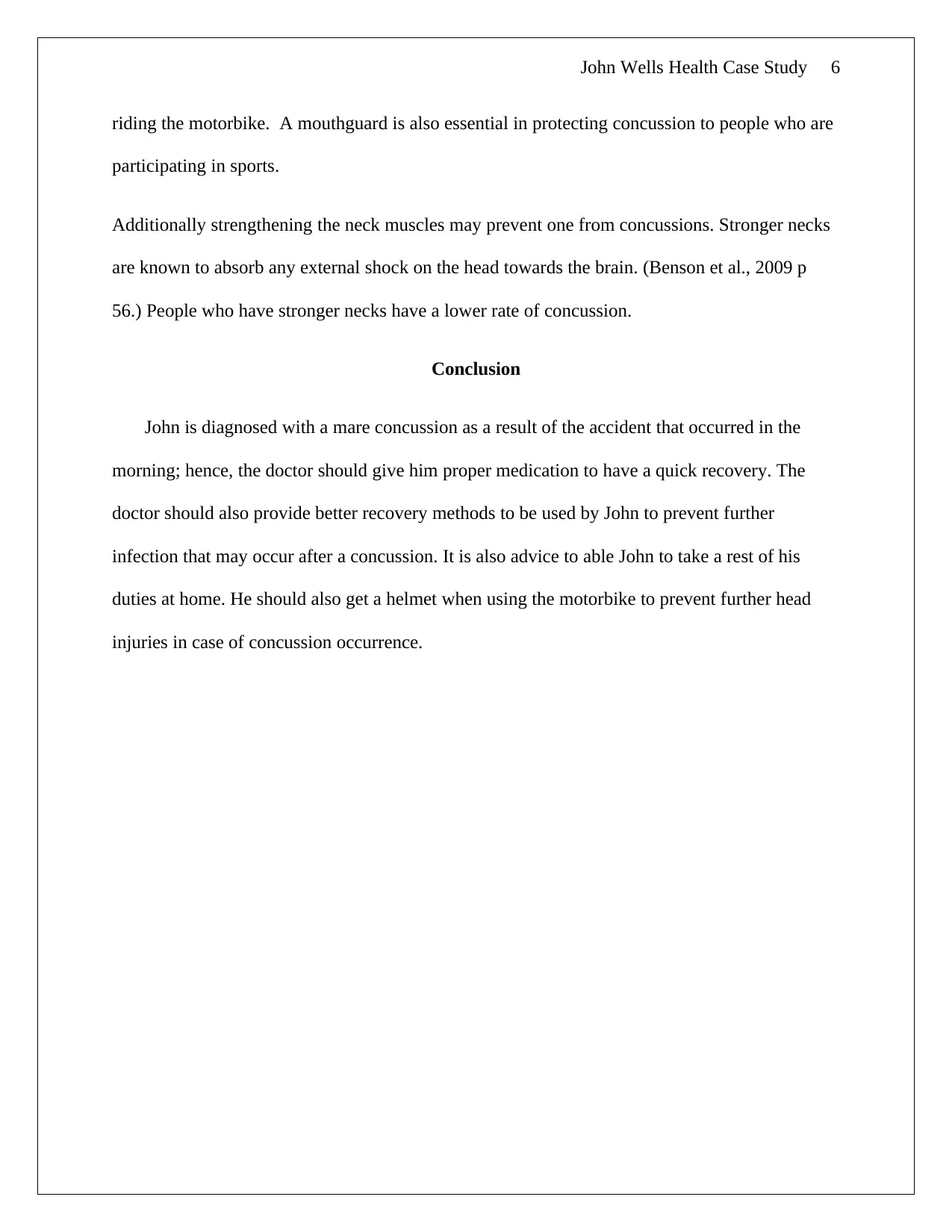John Wells Health Case Study 2022
VerifiedAdded on 2022/10/12
|8
|1974
|9
AI Summary
Contribute Materials
Your contribution can guide someone’s learning journey. Share your
documents today.

John Wells Health Case Study 1
JOHN WELLS HEALTH CASE STUDY
By (Name)
Course
Institution
Instructor
City and State
Date
JOHN WELLS HEALTH CASE STUDY
By (Name)
Course
Institution
Instructor
City and State
Date
Secure Best Marks with AI Grader
Need help grading? Try our AI Grader for instant feedback on your assignments.

John Wells Health Case Study 2
Introduction
Mild head trauma is one of the common cases that have led to the increase of death rates and
severe morbidity among many people depending on the cause of the trauma. A concussion is a
mild traumatic injury caused by a direct head impact or a whiplash-type of injury that causing the
head to shake unevenly back and forth. It may also be caused by an encephalic deceleration
effect which may produce spatial disorientation or even a partial unconsciousness of fewer than
24 hours (Paiva, 2011 p.175). Study shows that closed head injuries may result in physical or
social dysfunction among many patients. However, if quick action is taken for the mare head
injuries, further physical disabilities such as mental disorders may be prevented (Tator, 2013 p.
975). John Wells’ case helps us to understand more about how a concussion occurs and what
action to take during accidental injuries that cause concussions
Patients Profile and Situation
John is an 82-year-old farmer who lives with his wife Mavis in a local rural area. John has
one son by the name Sam, who lives in a neighboring property. Sam is always available to help
his parents in case of any need. Regardless of his age, John lives a healthy life though he is
diagnosed with mild hypertension, that's why he can do various physical activities such as going
for dairy in the morning. One morning John pulls outside on a two-wheeled motorbike heading
to dairy. Unfortunately, John became unbalanced and fell off of the motorcycle. The bike is
stationary at the moment strikes the left side of his head on the hard summer ground. Seeing that
John rarely wears a helmet, he sustains minor skin tear to his left forearm and a small abrasion to
his left elbow. Even after the injuries, John denies pain, stiffness, or reduced range of movement
Introduction
Mild head trauma is one of the common cases that have led to the increase of death rates and
severe morbidity among many people depending on the cause of the trauma. A concussion is a
mild traumatic injury caused by a direct head impact or a whiplash-type of injury that causing the
head to shake unevenly back and forth. It may also be caused by an encephalic deceleration
effect which may produce spatial disorientation or even a partial unconsciousness of fewer than
24 hours (Paiva, 2011 p.175). Study shows that closed head injuries may result in physical or
social dysfunction among many patients. However, if quick action is taken for the mare head
injuries, further physical disabilities such as mental disorders may be prevented (Tator, 2013 p.
975). John Wells’ case helps us to understand more about how a concussion occurs and what
action to take during accidental injuries that cause concussions
Patients Profile and Situation
John is an 82-year-old farmer who lives with his wife Mavis in a local rural area. John has
one son by the name Sam, who lives in a neighboring property. Sam is always available to help
his parents in case of any need. Regardless of his age, John lives a healthy life though he is
diagnosed with mild hypertension, that's why he can do various physical activities such as going
for dairy in the morning. One morning John pulls outside on a two-wheeled motorbike heading
to dairy. Unfortunately, John became unbalanced and fell off of the motorcycle. The bike is
stationary at the moment strikes the left side of his head on the hard summer ground. Seeing that
John rarely wears a helmet, he sustains minor skin tear to his left forearm and a small abrasion to
his left elbow. Even after the injuries, John denies pain, stiffness, or reduced range of movement

John Wells Health Case Study 3
to his neck, chest, and limbs. John’s wife Mavis being concerned about the situation calls Sam to
take the father to the hospital.
Sam takes John to the hospital and directly taken to an emergency department experiencing
headache, nausea, and mild confusion. John also has a hazy feeling though he denies having lost
consciousness. John is not well. Focusing on the signs and symptoms from John, he may be
experiencing concussions. A concussion is traumatic brain disturbance as a result of a blow or
direct injury to the head, triggering the brain nerves. Concussions are accompanied by headache,
fuzzy feeling difficulty in concentration and nausea.
In some cases there may be a blood clot in the brain which may be more dangerous
(Cdc.gov, 2019). Like John, who is denying pain and further injuries people who experiencing
concussions may not admit the problem they are facing or understand the future complications
they might face. Concussions problems may come later since the signs and symptoms are
difficult to tell. The symptoms of a concussion are generally caused by functional disturbance
but not a structural injury (Wilson, 2016 p.1).
Cues collected and Information
According to the emergency results, John has been experiencing headache nausea and mild
confusion after falling off from the motorbike and hitting his head. He also felt dizzy, a sign of a
concussion. Furthermore, performing a Röntgen radiation of his head since he is experiencing
headache and mild confusion after the incidence may help to get enough evidence of shock. The
doctor may also use Computed Tomography (CT) in order to check whether there may be hidden
internal bleeding or bruise in the brain. Examining the emergency information and the
questionnaire conducted in the hospital such as Respiratory rate of 17Bpm, the blood pressure of
to his neck, chest, and limbs. John’s wife Mavis being concerned about the situation calls Sam to
take the father to the hospital.
Sam takes John to the hospital and directly taken to an emergency department experiencing
headache, nausea, and mild confusion. John also has a hazy feeling though he denies having lost
consciousness. John is not well. Focusing on the signs and symptoms from John, he may be
experiencing concussions. A concussion is traumatic brain disturbance as a result of a blow or
direct injury to the head, triggering the brain nerves. Concussions are accompanied by headache,
fuzzy feeling difficulty in concentration and nausea.
In some cases there may be a blood clot in the brain which may be more dangerous
(Cdc.gov, 2019). Like John, who is denying pain and further injuries people who experiencing
concussions may not admit the problem they are facing or understand the future complications
they might face. Concussions problems may come later since the signs and symptoms are
difficult to tell. The symptoms of a concussion are generally caused by functional disturbance
but not a structural injury (Wilson, 2016 p.1).
Cues collected and Information
According to the emergency results, John has been experiencing headache nausea and mild
confusion after falling off from the motorbike and hitting his head. He also felt dizzy, a sign of a
concussion. Furthermore, performing a Röntgen radiation of his head since he is experiencing
headache and mild confusion after the incidence may help to get enough evidence of shock. The
doctor may also use Computed Tomography (CT) in order to check whether there may be hidden
internal bleeding or bruise in the brain. Examining the emergency information and the
questionnaire conducted in the hospital such as Respiratory rate of 17Bpm, the blood pressure of

John Wells Health Case Study 4
148/84mmHg, and the pulse rate of SpO2: 97% on room air will help identify the clinical effect
from the accident. Questioning John on how he may be feeling may help us gather more
information and come to firm conclusion Moreover connecting to both vital signs and symptoms
will help us analyses our cues which help know the condition of John. Using Sideline
Concussion Assessment Tool 5 (SCAT5) may be helpful to determine the rate of the head injury
caused by the motorbike during the accident. Monitoring advancement any of the signs and
symptoms of neurologic failure after an injury is also necessary for getting the actual findings.
Processing Information
Referring to John's case, he may have suffered from a traumatic brain injury after falling off
from the motorbike. John complains that he is experiencing a headache and Nausea; symptoms
that are related to Traumatic brain injury (TBI). Using a CT scan may show brain abnormalities
and hemorrhagic contusion, which may be brought by excessive internal bleeding if any. John’s
head may have sustained internal physical injuries altering skull tissues, therefore, leading to
Concussion (Kurland et al., 2012 p. 20). John is feeling hazy, mild headache, and nausea;
referring to data from the emergency department. The signs indicate John may be experiencing a
traumatic problem and suffering from a concussion due to the injury he sustained during the
accident. Johns head may have faced concussive injuries causing subsequent deceleration forces
to the brain causing John to have a transient mental status such as slight unconsciousness and
confusion (Jang and Lee, 2017 p. 1534). Additionally, John had not eaten dinner at night and no
breakfast before the incidence. John might have experienced a nausea feeling, causing him to
lose his appetite. Nausea feeling is subject to a concussion which may not be as a result of direct
head impact but direct acceleration forces without any actual contact (Ledic et al., 2012 p 23).
Vital signs were taken from the emergency department; of blood pressure 148/84 mmHg and
148/84mmHg, and the pulse rate of SpO2: 97% on room air will help identify the clinical effect
from the accident. Questioning John on how he may be feeling may help us gather more
information and come to firm conclusion Moreover connecting to both vital signs and symptoms
will help us analyses our cues which help know the condition of John. Using Sideline
Concussion Assessment Tool 5 (SCAT5) may be helpful to determine the rate of the head injury
caused by the motorbike during the accident. Monitoring advancement any of the signs and
symptoms of neurologic failure after an injury is also necessary for getting the actual findings.
Processing Information
Referring to John's case, he may have suffered from a traumatic brain injury after falling off
from the motorbike. John complains that he is experiencing a headache and Nausea; symptoms
that are related to Traumatic brain injury (TBI). Using a CT scan may show brain abnormalities
and hemorrhagic contusion, which may be brought by excessive internal bleeding if any. John’s
head may have sustained internal physical injuries altering skull tissues, therefore, leading to
Concussion (Kurland et al., 2012 p. 20). John is feeling hazy, mild headache, and nausea;
referring to data from the emergency department. The signs indicate John may be experiencing a
traumatic problem and suffering from a concussion due to the injury he sustained during the
accident. Johns head may have faced concussive injuries causing subsequent deceleration forces
to the brain causing John to have a transient mental status such as slight unconsciousness and
confusion (Jang and Lee, 2017 p. 1534). Additionally, John had not eaten dinner at night and no
breakfast before the incidence. John might have experienced a nausea feeling, causing him to
lose his appetite. Nausea feeling is subject to a concussion which may not be as a result of direct
head impact but direct acceleration forces without any actual contact (Ledic et al., 2012 p 23).
Vital signs were taken from the emergency department; of blood pressure 148/84 mmHg and
Secure Best Marks with AI Grader
Need help grading? Try our AI Grader for instant feedback on your assignments.

John Wells Health Case Study 5
Respiratory Rate: 17 Bpm, which is higher than usual might be as a result of physical head
injuries from the incident. The heart may increase the blood flow to the brain and other organs by
cardiac output. The high blood flow from the center to the brain will accelerate the concussion
healing process. Consequently, John blood pressure may increase than usual to hasten the
healing process. (The Conversation, 2019)
Concussions may be dangerous if not well managed and may lead to death. They have
psychological consequences, such as depression, anxiety, and behavior change. Study shows that
long term concussion may lead to Post-traumatic epilepsy which may develop after Traumatic
Brain Injury (TBI) when the brain is severely traumatized or when metabolic disturbed (Chang,
2012 p.62). Chronic encephalopathy may appear to a concussion victim if there is a continuously
repeated concussion. Primarily it is degeneration of the brain, which is as a result of the death of
neurons that are being killed by continuous head injuries. Relatively good medical care should be
given to John to prevent further concussions which may cause epilepsy infections.
John may suffer from post-concussion Syndrome if the treatment of the early concussion is not
taken seriously. The syndrome is generally caused by the trauma of the head and continuous
untreated concussions. The syndrome is a heterogeneous state accompanied by somatic and
domains (Smith, 2017, p. 77). The infection is familiar to people who have symptoms like
headache, fatigue, and amnesia.
Concussion Management
Following John's case, concussions can be prevented. If John would have won a helmet, there
could be no severe injuries on his head, causing the shock. One should ensure the helmet is fit for
a particular activity and worn correctly. In the future, John should wear a protective helmet when
Respiratory Rate: 17 Bpm, which is higher than usual might be as a result of physical head
injuries from the incident. The heart may increase the blood flow to the brain and other organs by
cardiac output. The high blood flow from the center to the brain will accelerate the concussion
healing process. Consequently, John blood pressure may increase than usual to hasten the
healing process. (The Conversation, 2019)
Concussions may be dangerous if not well managed and may lead to death. They have
psychological consequences, such as depression, anxiety, and behavior change. Study shows that
long term concussion may lead to Post-traumatic epilepsy which may develop after Traumatic
Brain Injury (TBI) when the brain is severely traumatized or when metabolic disturbed (Chang,
2012 p.62). Chronic encephalopathy may appear to a concussion victim if there is a continuously
repeated concussion. Primarily it is degeneration of the brain, which is as a result of the death of
neurons that are being killed by continuous head injuries. Relatively good medical care should be
given to John to prevent further concussions which may cause epilepsy infections.
John may suffer from post-concussion Syndrome if the treatment of the early concussion is not
taken seriously. The syndrome is generally caused by the trauma of the head and continuous
untreated concussions. The syndrome is a heterogeneous state accompanied by somatic and
domains (Smith, 2017, p. 77). The infection is familiar to people who have symptoms like
headache, fatigue, and amnesia.
Concussion Management
Following John's case, concussions can be prevented. If John would have won a helmet, there
could be no severe injuries on his head, causing the shock. One should ensure the helmet is fit for
a particular activity and worn correctly. In the future, John should wear a protective helmet when

John Wells Health Case Study 6
riding the motorbike. A mouthguard is also essential in protecting concussion to people who are
participating in sports.
Additionally strengthening the neck muscles may prevent one from concussions. Stronger necks
are known to absorb any external shock on the head towards the brain. (Benson et al., 2009 p
56.) People who have stronger necks have a lower rate of concussion.
Conclusion
John is diagnosed with a mare concussion as a result of the accident that occurred in the
morning; hence, the doctor should give him proper medication to have a quick recovery. The
doctor should also provide better recovery methods to be used by John to prevent further
infection that may occur after a concussion. It is also advice to able John to take a rest of his
duties at home. He should also get a helmet when using the motorbike to prevent further head
injuries in case of concussion occurrence.
riding the motorbike. A mouthguard is also essential in protecting concussion to people who are
participating in sports.
Additionally strengthening the neck muscles may prevent one from concussions. Stronger necks
are known to absorb any external shock on the head towards the brain. (Benson et al., 2009 p
56.) People who have stronger necks have a lower rate of concussion.
Conclusion
John is diagnosed with a mare concussion as a result of the accident that occurred in the
morning; hence, the doctor should give him proper medication to have a quick recovery. The
doctor should also provide better recovery methods to be used by John to prevent further
infection that may occur after a concussion. It is also advice to able John to take a rest of his
duties at home. He should also get a helmet when using the motorbike to prevent further head
injuries in case of concussion occurrence.

John Wells Health Case Study 7
Bibliography
Benson, B., Hamilton, G., Meeuwisse, W., McCrory, P., and Dvorak, J. (2009). Is protective
equipment useful in preventing a concussion? A systematic review of the literature. British
Journal of Sports Medicine, 43(Suppl_1), pp.i56-i67.
Chang, J. (2012). Complications of Traumatic Brain Injury - Post-traumatic Headache and
Epilepsy. Brain & Neurorehabilitation, 5(2), p.62.
Cdc.gov. (2019). Symptoms of Traumatic Brain Injury (TBI) | Concussion | Traumatic Brain
Injury | CDC Injury Center. [Online] Available at
https://www.cdc.gov/traumaticbraininjury/symptoms.html [Accessed 17 Sep. 2019].
Jang, S., and Lee, H. (2017). Traumatic axonal injury despite clinical phenotype of mild
traumatic brain injury: a case report. Brain Injury, 31(11), pp.1534-1537.
Kurland, D., Hong, C., Aarabi, B., Gerzanich, V., and Simard, J. (2012). Hemorrhagic
Progression of a Contusion after Traumatic Brain Injury: A Review. Journal of Neurotrauma,
29(1), pp.19-31.
Ledic, D., Sosa, I., Linic, I., Cvijanovic, O., Kovacevic, M., Desnica, A. and Banicek, I. (2012).
Vomiting as a reliable sign of a concussion. Medical Hypotheses, 78(1), pp.23-25.
Paiva, W. (2011). Classification and management of mild head trauma. International Journal of
General Medicine, p.175.
Smith, S. (2017). Post-concussion Syndrome: An Overview for Clinicians. Psychiatric Annals,
47(2), pp.77-82.
Bibliography
Benson, B., Hamilton, G., Meeuwisse, W., McCrory, P., and Dvorak, J. (2009). Is protective
equipment useful in preventing a concussion? A systematic review of the literature. British
Journal of Sports Medicine, 43(Suppl_1), pp.i56-i67.
Chang, J. (2012). Complications of Traumatic Brain Injury - Post-traumatic Headache and
Epilepsy. Brain & Neurorehabilitation, 5(2), p.62.
Cdc.gov. (2019). Symptoms of Traumatic Brain Injury (TBI) | Concussion | Traumatic Brain
Injury | CDC Injury Center. [Online] Available at
https://www.cdc.gov/traumaticbraininjury/symptoms.html [Accessed 17 Sep. 2019].
Jang, S., and Lee, H. (2017). Traumatic axonal injury despite clinical phenotype of mild
traumatic brain injury: a case report. Brain Injury, 31(11), pp.1534-1537.
Kurland, D., Hong, C., Aarabi, B., Gerzanich, V., and Simard, J. (2012). Hemorrhagic
Progression of a Contusion after Traumatic Brain Injury: A Review. Journal of Neurotrauma,
29(1), pp.19-31.
Ledic, D., Sosa, I., Linic, I., Cvijanovic, O., Kovacevic, M., Desnica, A. and Banicek, I. (2012).
Vomiting as a reliable sign of a concussion. Medical Hypotheses, 78(1), pp.23-25.
Paiva, W. (2011). Classification and management of mild head trauma. International Journal of
General Medicine, p.175.
Smith, S. (2017). Post-concussion Syndrome: An Overview for Clinicians. Psychiatric Annals,
47(2), pp.77-82.
Paraphrase This Document
Need a fresh take? Get an instant paraphrase of this document with our AI Paraphraser

John Wells Health Case Study 8
Tator, C. (2013). Concussions and their consequences: current diagnosis, management and
prevention. Canadian Medical Association Journal, 185(11), pp.975-979.
The Conversation. (2019). How concussion stresses the heart to protect the brain. [online]
Available at: https://theconversation.com/how-concussion-stresses-the-heart-to-protect-the-
brain-100729 [Accessed 18 Sep. 2019].
Wilson, H. (2016). Concussion: an Introduction. Shock, 1(1).
Tator, C. (2013). Concussions and their consequences: current diagnosis, management and
prevention. Canadian Medical Association Journal, 185(11), pp.975-979.
The Conversation. (2019). How concussion stresses the heart to protect the brain. [online]
Available at: https://theconversation.com/how-concussion-stresses-the-heart-to-protect-the-
brain-100729 [Accessed 18 Sep. 2019].
Wilson, H. (2016). Concussion: an Introduction. Shock, 1(1).
1 out of 8
Related Documents
Your All-in-One AI-Powered Toolkit for Academic Success.
+13062052269
info@desklib.com
Available 24*7 on WhatsApp / Email
![[object Object]](/_next/static/media/star-bottom.7253800d.svg)
Unlock your academic potential
© 2024 | Zucol Services PVT LTD | All rights reserved.





